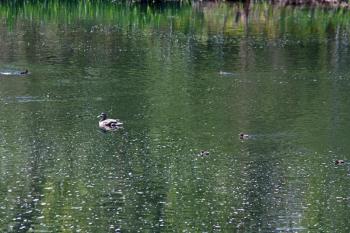CAMDEN — The Knox Mill pond in the spring of 2014 hosted a family of seven mallard ducklings, two females and five males, and this spring, it looks like the five males have returned, one of them with a mate and now 10 new ducklings.
The mallards, and others, have been seen on and off throughout the winter on the pond, which remained at least partially open due to the movement of the water as it runs through the Megunticook Dam on Molyneaux Road, and all the tributaries along the way south and east. At the foot of the pond is a waterfall with a lock that helps regulate the water level, after which the river continues through downtown Camden, under Main Street, over another waterfall and then empties into the head of Camden Harbor.
Last year, mid-summer and not yet fully grown, at least two of the 2014 ducklings were witnessed standing too close to the Knox Mill waterfall, when the current swept their feet out from under them and they tumbled head over tail. They popped up, apparently unscathed, and floated a ways down the river before swimming back and futilely attempting to go back the way they came. When their mother realized two of her clutch were missing, she frantically swam around the pond above, and called for them while their siblings followed close behind her.
The following day, all was made right, when the complete family of eight was once again seen swimming together on the pond. With wings not yet obviously fully developed for flying, it was hard to imagine how they managed to reconnect, but they did.
The 2015 ducklings Monday have been keeping busy, practicing their swimming, chasing insects and pollen on the water’s surface, and building up their strength and ability to paddle quickly for takeoff.
According to the Cornell Lab of Ornithology, mallard clutch size is 1-13 eggs, and the incubation period is 23-30 days. Only the female incubates the eggs and takes care of the ducklings, with mallard pairs being generally monogamous, although paired males pursue females other than their mates.
The standard duck's quack is the sound of a female mallard, according to the Cornell Lab. Males don't quack; they make a quieter, rasping sound.
The next few weeks will be when the ducklings are most vulnerable to predators and hypothermia. According to Ducks Unlimited, 50 percent of ducks do not survive their first year. It takes 50-70 days for ducklings to be able to fly, and they are excellent fare for nearly every type of predator, including large mouth bass and northern pike, bullfrogs, snakes and snapping turtles, and foxes, raccoons, mink and feral cats. Ducklings are also prone to becoming meals for other birds, including hawks, owls, gulls, herons and crows.
Related links:


2196.jpg)






























